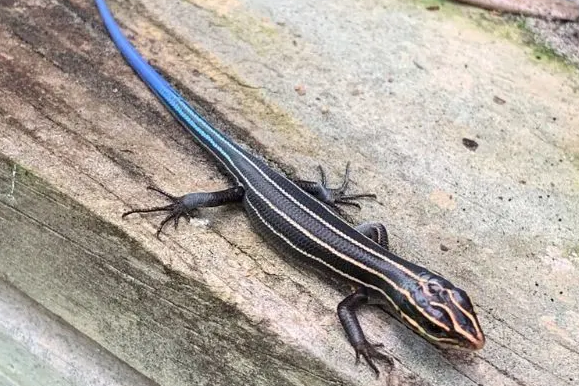Can you imagine all the things we could do if we had a tail? Well, we once did have a tail. In utero, babies start with a tail; tails get smaller and fuse into our vertebrae, creating our “tail-bone” around eight weeks. We miss out on some extraordinary abilities once we no longer have a tail. For animals, having a tail can provide balance, navigation, communication, mating rituals, marking territory, and defense.
Let’s talk about defense. Some lizards are notorious for losing their tails (autotomy) when humans or other animals attempt to catch them. I remember catching a green anole in my backyard as a kid. I was so excited to catch it but saw its tail come off as I grabbed it. The tail was then on the ground, still kind of wiggling around. As a child, that can seem pretty scary or even creepy, but it’s interesting that the lizard has this ability. Lizards have learned that they can save themselves from predators through the art of distraction.

When predators chase lizards, their tails can detach from their bodies; as the tail wiggles around on the ground, it directs the predator’s attention to the tail instead of them. Juvenile skinks (as pictured on the left) have a bright blue tail that is easily noticeable to predators. Although that might sound counteractive, luckily for skinks, their tail is expendable, and the skink can walk away unharmed. Once the tail has dropped, the lizard can regenerate its tail. However, the regenerated tail isn’t a replica of the original.
Now, if lizards can release their tails when faced with a predator, what happens when they encounter another one? How many times can a lizard release and regenerate its tail? Regeneration requires cells that will develop into tissues that become new muscles, cartilage, tendons, and eventually a regrown tail. Most lizards can live about 4 years or so, depending on the food, water, shelter, and predators. Depending on how big the lizard is and how healthy they are, it can take anywhere from a month to over a year to have a tail regenerate. So, if the lizard survives those months without a tail as it goes through the regeneration process, one single lizard can potentially drop and regenerate a few tails in its lifetime.
Next time you visit the River Legacy Nature Center and walk the trails, look for lizards like the ones in the images below. If you notice a brown patchy tail that doesn’t seem to match the rest of the body, or just looks like they’re missing a tail, they are in the regeneration process, and a new tail is on the way.


There is so much more to learn about lizards! Our upcoming visiting exhibit Here Be Dragons: From Lizards to Legends will feature 6 live lizards so visitors can learn about these legendary creatures up close and personal. Mark your calendars for November 19th and get ready to explore different realms, encounter living legends, and discover unique artifacts at the River Legacy Nature Center.
Visit our website for more details www.riverlegacy.org/here-be-dragons
Written by Sarah Morris, Naturalist.
